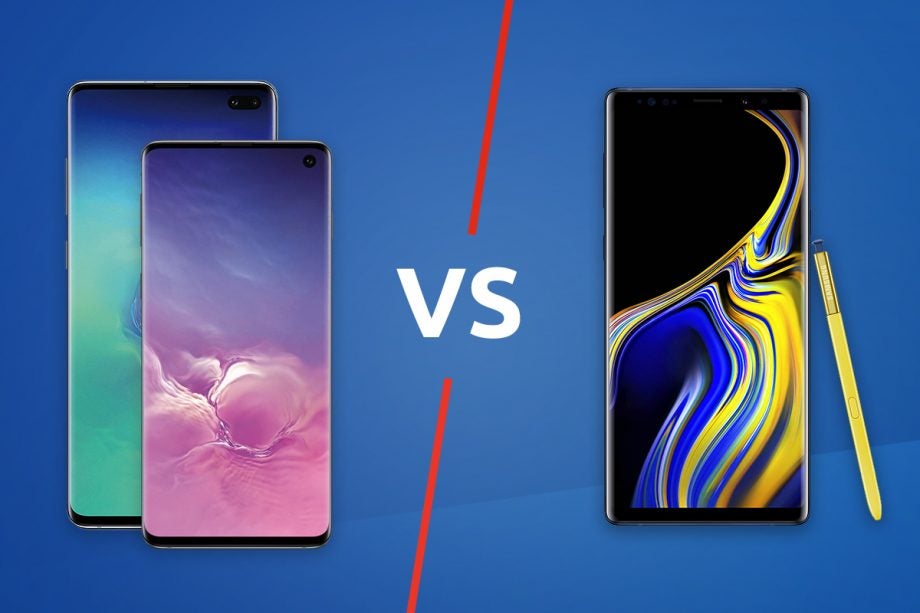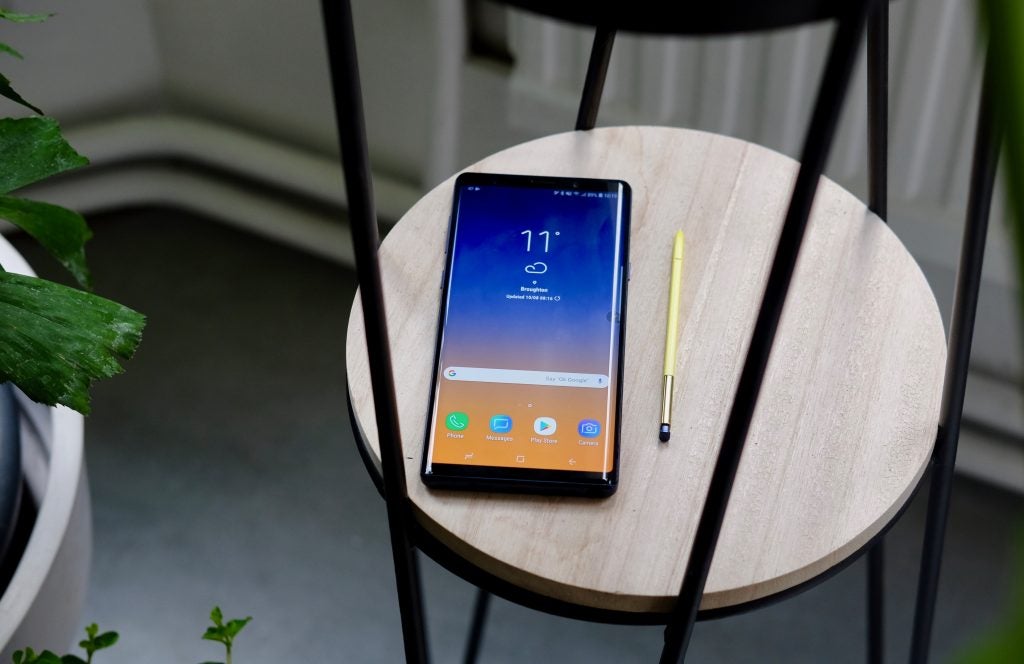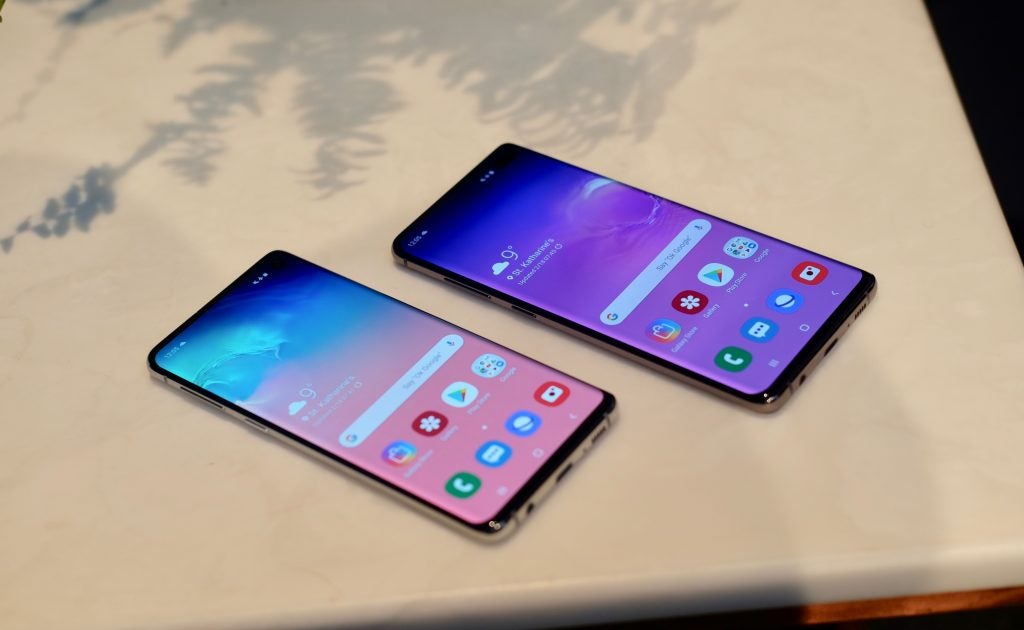Samsung Galaxy S10 / S10 Plus vs Samsung Galaxy Note 9

The Samsung Galaxy S10 has finally been announced, with a March release date fast approaching. But how does it, and its larger sibling – the Galaxy S10 Plus – compare to the company’s outgoing champ, the Samsung Galaxy Note 9?
Samsung Galaxy S10 / S10 Plus vs Note 9 – Design
Interestingly, while the Samsung Galaxy S10 and S10 Plus move a step away from their predecessors on the design front, they arguably take a step towards the Galaxy Note 9. Their appearance is altogether squarer than before, which suggests that Samsung took a few cues from its own brilliant phablet family. However, both the Galaxy S10 and the S10 Plus also kick things on a fair bit.
Most notably, these new Galaxy devices are almost all-screen. With a 93.1% screen-to-body ratio, we’re getting closer to true bezel-free status than we’ve ever been. That’s a considerably higher figure than the Galaxy Note 9’s 83.4%, at any rate.

Samsung Galaxy Note 9
Samsung has created this 10% gap by eating into the forehead and chin area of these new S10 devices. The bezels are super-slim compared to their Note 9 counterparts, to the point where the front-facing camera has to be housed within the display itself – an effect Samsung calls the “Infinity-O” display. The Galaxy Note 9 selfie-cam gets to luxuriate in its own thick border.
All these phones feature curved-edge displays, with side-bezels having been absent from Samsung’s flagship design handbook for some time. This should tell you that the Galaxy S10’s display is slightly longer than the Galaxy Note 9’s. It’s a 19:9 affair, compared to the older phone’s 18.5:9 aspect ratio. Despite this, the Galaxy Note 9’s screen remains bigger than the base S10 (6.4-inches versus 6.1-inches), although wider and shorter than the 6.4-inch panel on the S10 Plus.
From the rear, these devices look remarkably similar. In fact, the only difference is this year’s Galaxy’s triple-camera module. The Galaxy Note 9 has “only” the two.
As for the edges, all three phones pack a USB-C port and a 3.5mm headphone connector. Samsung is clinging on to that legacy audio standard, and we love the company dearly for doing so.
Related: Best smartphones
Samsung Galaxy S10 / S10 Plus vs Note 9 – Specs and features
The Samsung Galaxy Note 9 arguably packed the best smartphone display of 2018. But then, Samsung has always been responsible for the best smartphone screens.
The Samsung Galaxy S10 and S10 Plus’ screens look even better. We’ve already mentioned their extended aspect ratios, but that’s not the only change.
| Galaxy S10 | Galaxy S10 Plus | Galaxy Note 9 | |
|---|---|---|---|
| Dimensions | 149.9 x 70.4 x 7.8mm | 157.6 x 74.1 x 7.8mm | 161.9 x 76.4 x 8.8mm |
| Weight | 157g | 175g | 201g |
| Display | 6.1-inch, 19:9 (Edge), Wide Quad HD+, Dynamic AMOLED+ | 6.4-inch, 19:9 (Edge), Wide Quad HD+, Dynamic AMOLED+ | 6.4-inch, 18.5:9 (Edge), Quad HD+, Super AMOLED |
| Rear camera | Dual Pixel 12-megapixel OIS f/1.5 – f/2.4 AF + 16-megapixel ultra-wide f/2.2 FF + 12-megapixel telephoto OIS f/2.4 AF |
Dual Pixel 12-megapixel OIS f/1.5 – f/2.4 AF + 16-megapixel ultra-wide f/2.2 FF + 12-megapixel telephoto OIS f/2.4 AF |
Dual Pixel 12-megapixel OIS f/1.5 – f/2.4 AF + 12-megapixel telephoto OIS f/2.4 AF |
| Front camera | Dual Pixel 10-megapixel f/1.9 AF | Dual Pixel 10-megapixel f/1.9 AF + 8-megapixel f/2.2 AF depth camera |
8-megapixel f/1.7 AF |
| Memory | 8GB + 128GB or 8GB + 512GB – microSD up to 512GB (all versions) |
8GB + 128GB or 8GB + 512GB (ceramic version only) or 12GB + 1TB (performance version only) – microSD up to 512GB (all versions) |
6GB + 128GB or 8GB + 512GB – microSD up to 512GB (all versions) |
| Battery | 3400mAh | 4100mAh | 4000mAh |
| Charging | Wireless PowerShare Fast Wireless Charging 2.0 |
Wireless PowerShare Fast Wireless Charging 2.0 |
Fast Wireless Charging 2.0 |
| Security | In-display ultrasonic fingerprint sensor 2D face recognition |
In-display ultrasonic fingerprint sensor 2D face recognition |
Fingerprint sensor Iris scanner |
| Processor | Octa-core 8nm processor | Octa-core 8nm processor | Octa-Core 10nm processor |
| Network | Up to 7 CA, LTE Cat.20 | Up to 7 CA, LTE Cat.20 | Enhanced 4X4 MIMO/CA, LAA, LTE Cat.18 |
The Galaxy S10 screen gets ridiculously bright for an AMOLED panel, with a maximum brightness of 1200 nits max. The Galaxy Note 9 was capable of hitting 1130 nits.
HDR10+ compliance is present and correct on both S10 variants, trumping the Note 9’s standard HDR10 support. Last year, DisplayMate reported that the Galaxy Note 9 could hit 0.5 JNCD (Just Noticeable Color Difference), which translates to almost perfect colour accuracy. The Galaxy S10 gets even closer to perfection, to the tune of a 0.4 JNCD.
One noteworthy new feature of the Galaxy S10 handsets sits just beneath those beautiful displays. They adopt an in-display fingerprint sensor, so you’ll be able to rest your thumb on the lower portion of the screen to unlock the phone.

Samsung Galaxy S10 (left) and S10 Plus (right)
What’s even more interesting is that the Galaxy S10 adopts ultrasonic fingerprint technology, which is more secure than the optical efforts we’ve seen from the OnePlus 6T, for example. It’s certainly way ahead of the Galaxy Note 9’s traditional rear-mounted sensor – although, of course, it remains to be seen if it’s as quick or reliable.
Talking of changes under the hood, the Samsung Galaxy S10 line sees a considerable bump up in power over the Galaxy Note 9. You get either a 7nm Qualcomm Snapdragon 855 or Samsung’s 8nm Exynos chipset, depending on where in the world you purchase the device. The Galaxy Note 9 comes with a 10nm Snapdragon 845 or Exynos 9810.
That’s supported by 8GB of RAM as standard on the Galaxy S10 and S10 Plus; you have to splash out for the larger 512GB model of the Galaxy Note 9 to get the same headroom. The smaller 128GB model has just 6GB of RAM.
While the Galaxy Note 9 has a larger battery than the standard S10 (4000mAh versus 3400mAh), the Galaxy S10 has an additional trick up its sleeve. You can charge other wireless devices with the phone by way of Wireless PowerShare, which should come in handy with the new Galaxy Buds. The same feature can also be found on the S10 Plus – and it does boast a larger 4100mAh cell, compared to the Note 9.
The most unique feature in the Galaxy Note 9 is, of course, its S Pen. Each phablet packs an advanced stylus that allows you to scrawl notes and draw pictures on the screen, as well as acting as a remote control for the camera and other applications.
Samsung Galaxy S10 / S10 Plus vs Note 9 – Camera
The Samsung Galaxy S10 and S10 Plus take what appears to be the same basic camera setup as the Samsung Galaxy Note 9, and then add another camera into the mix.
All three phones have a 12-megapixel primary sensor with dual-pixel autofocus, optical image stabilisation, and an adjustable aperture that can switch between f/1.5 and f/2.4. In each case, this is accompanied by a 12-megapixel telephoto sensor with an f/2.4 aperture and OIS for a proper 2x optical zoom.
However, the Galaxy S10 and Plus also add in a super-wide-angle, 16-megapixel, f/2.2 aperture fixed-focus sensor.
Related: Best camera phones
One of the only differences between the Galaxy S10 and its Plus brother is that the smaller phone lacks a secondary front-facing camera for depth detection tricks. This places it a little closer to the Galaxy Note 9 on paper, although differences remain.
While the Samsung Galaxy Note 9 packs an 8-megapixel, f/1.7 selfie-cam, the Galaxy S10 goes with a dual-pixel, 10-megapixel, f/1.9 unit. The Plus’ secondary sensor takes the form of an 8-megapixel, f/2.2 autofocus depth camera.
Samsung Galaxy S10 / S10 Plus vs Note 9 – Price and availability
The Samsung Galaxy S10 and S10 Plus are available to pre-order from February 20 and are set to arrive in shops and on doorsteps on March 8. The S10 will cost £799 for the 128GB model and £999 for the 512GB model, while prices for the S10 Plus start at £899 (for the 128GB option); the 512GB version costs £1099. The special Performance Edition of the S10 Plus boasts 12GB of RAM and 1TB of internal storage, and will set you back a hefty £1399 SIM-free.
Obviously, the Samsung Galaxy Note 9 is available right now. It’s been a constant retail presence since its August 2018 release window.
Indeed, the fact that the Galaxy Note 9 has been out for six months now means that you can get one for a lower price. At launch, it cost £899 for the 6GB RAM/128GB model, and £1099 for the 8GB/512GB model.
At the time of writing, however, Samsung is selling the Note 9 at Galaxy S10 levels – so £799 for the 128GB and £999 for the 512GB model. We’d expect those prices to fall further as the Galaxy S10 line hits shops.
Early verdict
The Samsung Galaxy Note 9 still has its fans, and we’re among them. It remains one of the finest phones on the market, even after the Samsung Galaxy S10’s launch. If you want a highly capable all-rounder with a stylus, it’s still the best option.
However, there’s no getting away from the fact that the Galaxy S10 and S10 Plus both offer improvements across the board. They’re sleeker and more powerful, and include more sophisticated cameras and brighter screens. Right now, they simply offer better value for money.


